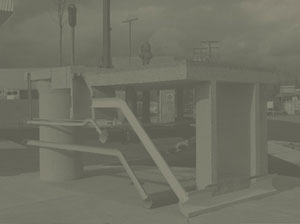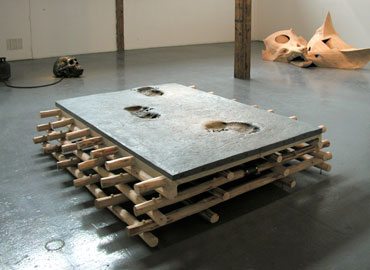Aug 2-30, 2002, SFU Visual Art Studios,
Alexander Centre, Vancouver BC
GLYPTOMANIA represents the first time in many years that a large number of BC's most committed sculptural and installation artists have shown together in one exhibition focused on three-dimensional work. Over the past several years in Vancouver spatial work has been less well represented than other artistic practices; what this exhibition demonstrates is the strength and criticality of work produced here, which continues to thrive in spite of irregular attention and severely limited exhibition opportunities. As a show, it is neither definitive nor inclusive and cannot hope to represent the considerable range of three-dimensional production in the region.
Sculpture as a category is no longer as clear as it once was, when it could be defined simply as any free-standing object produced by an artist in wood, stone or metal, with its own self-supporting structure. The limits of this description were already evident in the late nineteenth century, when sculpture’s connection to the monumental and to architecture lost its earlier integration. This definition is no longer the motivation for the majority of progressive practitioners. For contemporary artists, its limits are self-evident, and a wider range of possible practices more appropriate to the complexity of the contemporary situation have emerged.
Global corporatism has increasingly meant our things are made for us, and recycled for us, by low paid workers labouring in abyssmal environmental conditions for long hours in developing countries. Methods of selection and consumption have become comparative choices; the complexity of our relation to made things and their possible effects and uses has been radically transformed. The development of new visual vocabularies capable of reflecting these effects of increased globalization on contemporary life has become a necessary and compelling impulse for many working artists.
Many in this exhibition understand the contingency of their situation within a larger context of transnationally-produced made things. Increasingly a world of hyper-products fits Baudrillard's formulations of simulacra, as "copies without originals" Certainly the nature of commodity culture, and commercial production and consumption of consumer goods in general, has existed within artistic discourse since the beginning of the last century, when artists began developing strategies to foreground the complicated and uneasy relation between things and consumers. (Soviet experiments in Productivism and Factura; Duchamp's ready-made commodity as critique; the Bauhaus' pedagogic practices in relation to production; and Warhol's relation of artistic production to consumption.) During this period sculpture, as solely formalist practice retaining the extreme pleasures of self-contained aesthetic visuality, gave way to objects of contingent contextualization and social reflection.
Artists in this exhibition share a long-standing commitment to making things. Their interest in physically manipulating materials sets them apart from artists whose impulses are primarily conceptual, delegatory and directorial. They understand something from the hands-on, palpable, haptic wrangling with stuff as inchoate territory of origination and invention. They privilege comprehension gained through doing things directly, using knowledge that comes from constant observation turned to manipulation, and consideration of the constructed parts and processes of contemporary life made into things.
None of these artists subscribe to a monoculture of specialization. Their accumulated and eclectic range of skills, many more than the average person and unique to each of them, have become working methodologies applied to how the world works, and how it can be dismantled and reassembled for the attentive percipient. Driven by the needs of their projects, over time what they know how to do, even imperfectly, keeps expanding and angling off tangentially, improving their understanding of what we need to know about a relation to objects. Works in this exhibition offer spaces for reflection on what has been done for us by made things, what can be done, and insights into the nature of how material processes transform contemporary life.
This exhibition space is the Visual Art Studio of Simon Fraser University's School for the Contemporary Arts at Alexander Centre. It is near-ideal for the presentation of three dimensional work, and its availability made this show possible. This is the fourth exhibition here this summer; the previous three were produced by Orange Corporation, an artist's collective committed to creative critical exhibitions of visual art: Rehash was an exhibition of recent work by students from SFU, ECIAD, Capilano College, and UBC; Canning the Cyborg was a didactic response to the VAG's recent exhibition; Lost in Hollywood reflected film-based mediated imagery from popular culture.
The front space is named for Martin Bartlett, a friend, colleague and one of the most progressive composers and musicians to come out of Vancouver, and a founder of the Western Front. Martin died nine years ago, and the memory of his independent spirit and creativity has guided the impulse behind this exhibition.
We wish to thank the participating artists, whose generosity and commitment to the idea of this exhibition made it possible. Special thanks to all those who contributed to the show: Martin Gotfrit, Director, School for the Contemporary Arts, SFU; Sandi Lindahl, Operations Manager for SFU Harbour Centre; Frank Crema, Security, Alexander Centre; Heather and Toby Blakemore, catering; Jeremy Gilpin, studio technician; and especially the indefatigable Orange Corporation trio, Reece Terris, Nicole Raufeisen, and Ryan Witt.





GLYPTOMANIA
THE FIRST VANCOUVER SCULPTURE SHOW OF THE 21ST CENTURY
THE FIRST VANCOUVER SCULPTURE SHOW OF THE 21ST CENTURY
gregsnider.ca Copyright © 2007 - Greg Snider.
All Rights Reserved. contact: greg@gregsnider.ca




